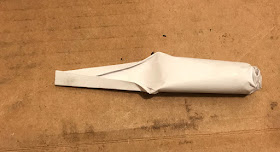The paper cartridges are rolled around a form to create a tube holding the ball and powder charge. Most people use a dowel for this but I have a metal lathe, so I made the form from a piece of 3/4" aluminum rod turned down to .69”. (Besides, it's been too long since I made some chips.)
I put a cavity on the end to help keep the ball in place when I’m rolling the cartridges.
Recipe:
- .690 ball by Rush Creek.
- 100 grains 2Fg Goex black powder. The original British service load was up to 165 grains of 1Fg powder, some of which was used for priming. I’ll prime from a flask. By most accounts, you get better accuracy from a smoothbore with stout loads.
- I used printer paper since it's what I had on hand.
Rather than tying the end I use a glue stick on the diagonal edge and ball end. As I understand it, French musket cartridges were made with glue while British rounds were tied.
I used this template, which I found after watching this excellent video by Tim Brieaddy:
Starting to roll the cartridge. At this point, I've gone over the diagonal edge with the glue stick.
Rolled almost all the way.
Forming the end.
Twenty five rolled cartridges, ready to fill.
Crimping the end and creating the tail that will be bit off prior to loading the musket.
And finally, a box of 25 ball cartridges.
I'll be going to a friend's place tomorrow to try them. I'm also bringing some loose .735" balls, powder, and patches to try patched round ball loads.
Range report to follow.









No comments:
Post a Comment
Because of spammers I review all comments before they are published.